Nutritional Requirements of Breeding Bulls
Nutritional Requirements of Breeding Bulls at Various Ages
Published: June 7, 2012
By: Syed Hassan Raza (University of Agriculture Faisalabad, Pakistan)
Introduction
There is a famous quotation that ´Bull is half of the dairy herd´, although this quotation mainly deals with his genetic worth but no body can ignore the environment´s effects on his contribution to his offspring. Amongst the number of environmental factors, the main is "nutrition". It is that part of management of breeding bulls that is always not only neglected but is ignored. If we review the work done on this aspect, there is only disappointment. Only few and scanty work is done and unfortunately, no systematic work on the nutrient requirements of breeding bull has been conducted in Pakistan. On the other hand a substantial work on this respect has been done in India.
The practical feeding of the breeding bull is related to the nutrient requirement for various physiological functions which are to be provided daily for the best performance of breeding bull. The term "requirement" is defined as the amount of the nutrient that must be supplied in the ration to meet the needs of the normal healthy animal given an otherwise nutritionally adequate diet in a hygienic environment for maintenance and various forms of production are derived by conducting a number of experiments with animals exhibiting different physiological functions.
Work in Pakistan
The rearing of buffalo and Sahiwal calves is necessary for the production of superior germ plasm. Better management and optimum feeding brings early maturity and narrow the gap of generation interval.
The main objective of good management and balanced feeding of bull calves/young bulls, is to obtain optimum growth and early maturity. The maturity is associated more with weight and less with age. It has also been established that certain breeds of animals have some specific potential for growth performance and sometimes they grow faster and get maturity weight earlier when the genitalia and the hormonal profile has not yet been fully developed. So, feeding of young bulls should aim at getting maturity at the age when the sexual organs are fully functional to produce matured sperms. In other words the maturity age is that when the bull attains its breeding capability.
Although different researchers have tried different forms of feeding young bulls to establish some definite feeding schedule for the bulls, yet there seems much variation in growth and feed requirements for buffaloes, bulls to achieve early maturity. A number of studies have been undertaken at Livestock Production Research Institute, Bahadurnagar (Okara) to study the growth performance in young bulls for early maturity and better productivity, with encouraging results.
The bulls, selected under different schedules of feeding, matured at the age of 18-22 months gaining 60 percent adult body weight but took some more time to donate semen on dummy at the age of 22-26 months with 66% of the adult body weight. The average age and weight at first fruitful ejaculation was recorded as 26 months. The individual cases have been recorded where the bulls have donated semen at the age of 19 months or even earlier but their performance is yet, to be confirmed in this breed.
The bull calves were fed concentrate supplement @ 1% of their body weight and green fodder ad-lib. On the average the bulls consumed 7.98 kg dry matter and 5.18 kg TDN for gain of 1 kg live weight. The feed efficiency decreased with increase in live weight up to m 400 kg and then again showed upward trend.
The results of this study were compared with NRC requirements. This rough estimation of nutrition requirements for Nili-Ravi buffaloes bulls indicated that the buffalo feed requirement falls near to the requirements of large European milch breeds of cattle.
Ranjhan (1980) reported similar results in fattening trail of buffalo calves. He reported that buffalo calves consumed 2.5 to 3.0 percent of their body weight when fed on good roughage´s supplemented with concentrates. The DCP consumed was 290 gm to 340/100 kg. The live weight of calves increased at the rate of 0.5 to 0.7 kg per day (Asghar, 1988).
In another study, twenty male calves each form Nili-Ravi and Sahiwal breeds were taken and divided into two groups on the basis of live weight. The average live weight of buffalo groups A&B was 362.5 and 225 kg respectively. In Sahiwal A&B groups the average live weight was 354 and 212 kg, respectively. The ration was given to the animals according to the NRC feeding standard. The experiment was continued for sixty days.
The buffalo calves of group A&B consumed 14.32 & 11.35 kg of dry matter (DM) and 1.57 & 1.19 kg of crude protein (CP) with daily growth of 0.92 & 1.17 kg respectively.
Likewise, the group A&B of Sahiwal calves gained growth of 0.83 & 1.00 kg with the consumption of 15.22 & 11.40 kg DM and 3.06 & 1.21 kg of CP. The growth rate was higher in buffalo calves than Sahiwal and also higher in young than old calves (Ahmad and Asghar, 1994).
Requirement for Growth
The nutrient requirement in the case of growing calves can be divided in two phases, namely pre ruminant growth period that is, before rumen is anatomically and physiologically developed and post-ruminant growht, that is, after rumen has been developed.
Pre-Ruminant Growth (From Birth to 3 Months of Age)
A major portion of the requirements of energy and protein for the pro-ruminant calves (birth to 3 month of age) are met by whole and skim milk. New born calves start eating dry foods like calf starter and hay from the second week after birth in small quantities. The consumption of these dry foods will gradually increase if the milk allowance of the calf is gradually reduced. Calves getting large quantities of milk may not consume calf starter and hay in appreciable quantities so as to contribute a significant protein of their energy and protein requirement. The duration of milk/skim milk feeding ranges from as low as birth to 45 days of age to as high as birth to 6 months of age, a liberal milk feeding up 6 month of age gave growth rate of 660 g per day from birth to 6 months of age but grown was reduced to 360 g on limited milk intake.
In formulating the feeding schedules of calves it has been accepted that after 60 days of age it is not necessary to feed whole or skim milk. The total quantity of milk (may not increase beyond 140 kg in 60 day time and there is the same growth rate up to 3 month of age in bull.
Nutrient Requirements of Pre-Ruminant Cattle And Buffalo Calves
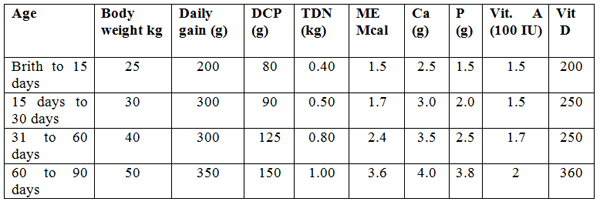
Nutrition Requirement for Breeding Bulls
Mature breeding bulls are fed with adequate nutrition in order to maintain them physically active as well as to maintain the body weight. Overfeeding should not be done. Under farm conditions, about 40-50 kg green fodder and 2-3 kg of wheat or paddy straw will be sufficient. Adequate minerals and vitamins should be provided to maintain the quality of semen (Gopalkrishnan and Lal, 1993).
Nutritive Requirements of 600 kg Buffalo Bull

Ration 1. 40 kg green oats maize + 3 kg wheat or paddy straw
Ration 2. 5 kg green grass + 2 kg concentrate mixture + 8 kg wheat or paddy straw
Ration 3. Green berseem 30 kg + wheat or paddy straw 8 kg.
Ration 4. Green maize 30 kg + wheat or paddy straw 6 kg + 0.5 kg concentrate mixture
Ration 5. Fodder jowar 30 kg + wheat or paddy straw 6 kg + 1 kg groundnut oil cake.
A bull requires more nutrients to maintain body weight than a dry cow of comparable body weights. For a bull in service, there should be adequate provision of protein which dependent on the number of service per week. Assuming that number of service is 4 in a week, the requirement of protein of bull may be calculated at about 40% more DCP than comparable body weight of a dry cow.
Maintenance Requirements of Mature Breeding Bulls

Metabolically Energy Requirements (MJ/Day) of Cattle for Maintenance and Growth (A) Bulls of Breeds of Large Mature Size
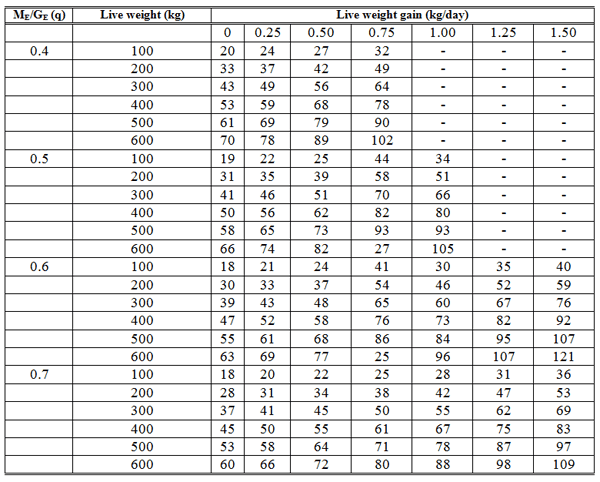
Metabolically energy requirements (MJ/day) of cattle for maintenance and growth (B) Bulls of breeds of medium mature size.
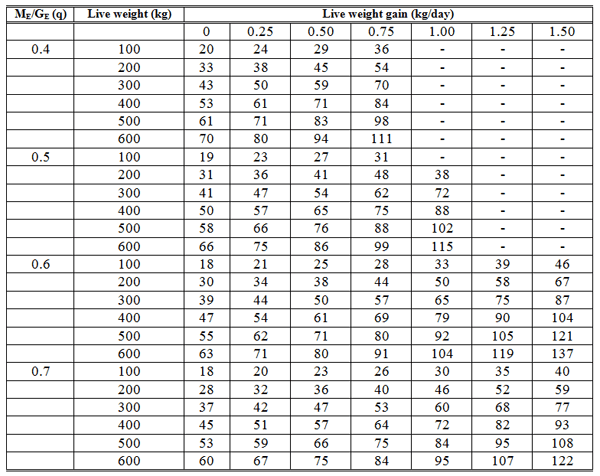
Metabolically energy requirements (MJ/day) of cattrle for maintenance and growth (C) Bulls of breeds of small mature size.
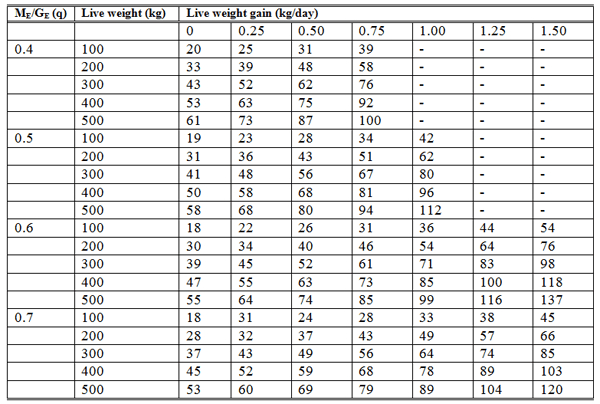
Ruemen-degradeable (RDP) and Undegraded (UDP) protein requirements (g/day) of cattle for maintenance and growth:Bulls of breeds of large mature size.
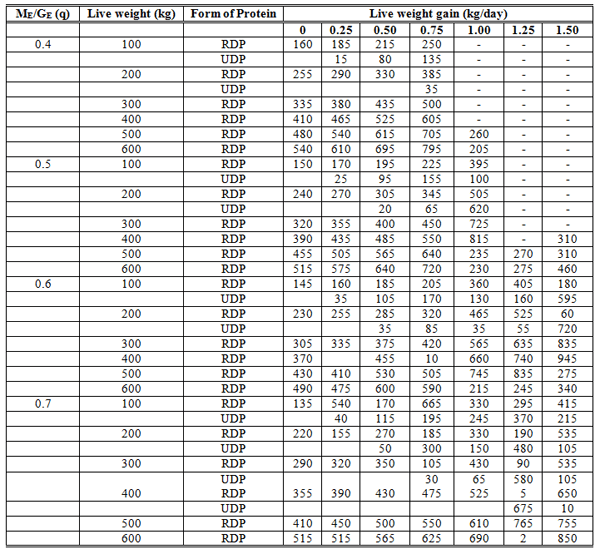
Rumen-degradeable (RDP) and Undergraded (UDP) protein requirements (g/day) of cattle for maintenance and growth: (B) Bulls of breeds of medium mature size.

Rumen-Degradable (RDP) and Undergraded (UDP) Protein Requirements (g/Day) of Cattle for Maintenance and Growth :Bulls of Breeds of Small Mature Size.
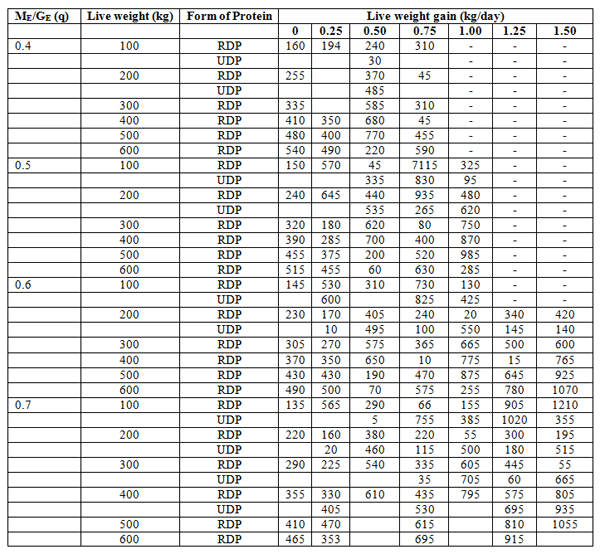
Dietary Requirements (g/Day) for Calcium of Animals Gaining at Different Rates

Dietary Requirements (g/day) of Phosphorus for Animals Gaining at Different Rates

Suggestion:
1. Overfeeding should be avoided as it leads to excessive fattening which lowers the libido.
2. Three years old bulls should be used for service
3. Good management and exercise of bull be regularized
4. Good quality of energy and protein sources be provided
5. Vitamin A and E along with minerals specially Calcium, Phosphorus and Manages should be provided during all ages of bull.
6. There is a dire need to establish feeding standards for breeding bulls of local breeds for this purpose long term research projects should be launched with best scientific imputes at farm and in field levels.
REFERENCES
Ahmad, M. and A.A. Ali. 1994. Growth rate in buffalo and Sahiwal calves under optimum feeding conditions. 15 Annjual Rep., LPRI, Bahadar Nagar, Okara, Pakistan: 59-60.
Agricultural Re.s Council Working Party. 1988. The Nutrient Reqts. of Ruminant Livestock. CAB. UK. Asghar, A.A. 1988. Studies Required for Development of Progeny Tested Bulls to Improve Buffalo Milk Production in Punjab. 4th ann. Rep., LPRI, Bahadar Nagar, Okara, Pakistan:40-41.
Gopalkrishnan, C.A. and G.M. Lal. 1993. Livestock and Poultry Enterprises for Rural Development. Vikas. Pub. House, Delhi, India.:362-363.
MAFF Ministry of Agriculture, Fisheries and Food.
Related topics:
Recommend
Comment
Share
20 de enero de 2021
Yes I agree to other commentators that this is a field given little attention. The author has made a commendable effort in dealing with this issue. I would suggest to other authors, who read all these comments, to further elaborately write over the subject
Recommend
Reply
16 de julio de 2018
Thank you so very much for your nice research. Really data on a systematic study on breeding bull, especially breed wise are scanty. In the case of sahiwal bull, this situation is so vulnerable. For a couple of months, I'm looking for data of nutrition requirement as per body weight, age and body weight gain.
Thanks.
(working in the field of breed development)
Recommend
Reply
12 de julio de 2012
Dear Sir, very informative article, congratulations. Provide micro minerals requirements also as semen quality and quantity is affected by those.
Recommend
Reply
Recommend
Reply
9 de julio de 2012
Indeed a lesser addressed topic given its due importance. I shall be happy to know the ration specifications with ref to specific breeds and if it has a significant statistics available.
Congratulations to the scientists for a well thought topic.
Recommend
Reply
9 de julio de 2012
beautiful try and brain storming article towards an issue which is normally neglected by breeders
Recommend
Reply

Would you like to discuss another topic? Create a new post to engage with experts in the community.








.jpg&w=3840&q=75)